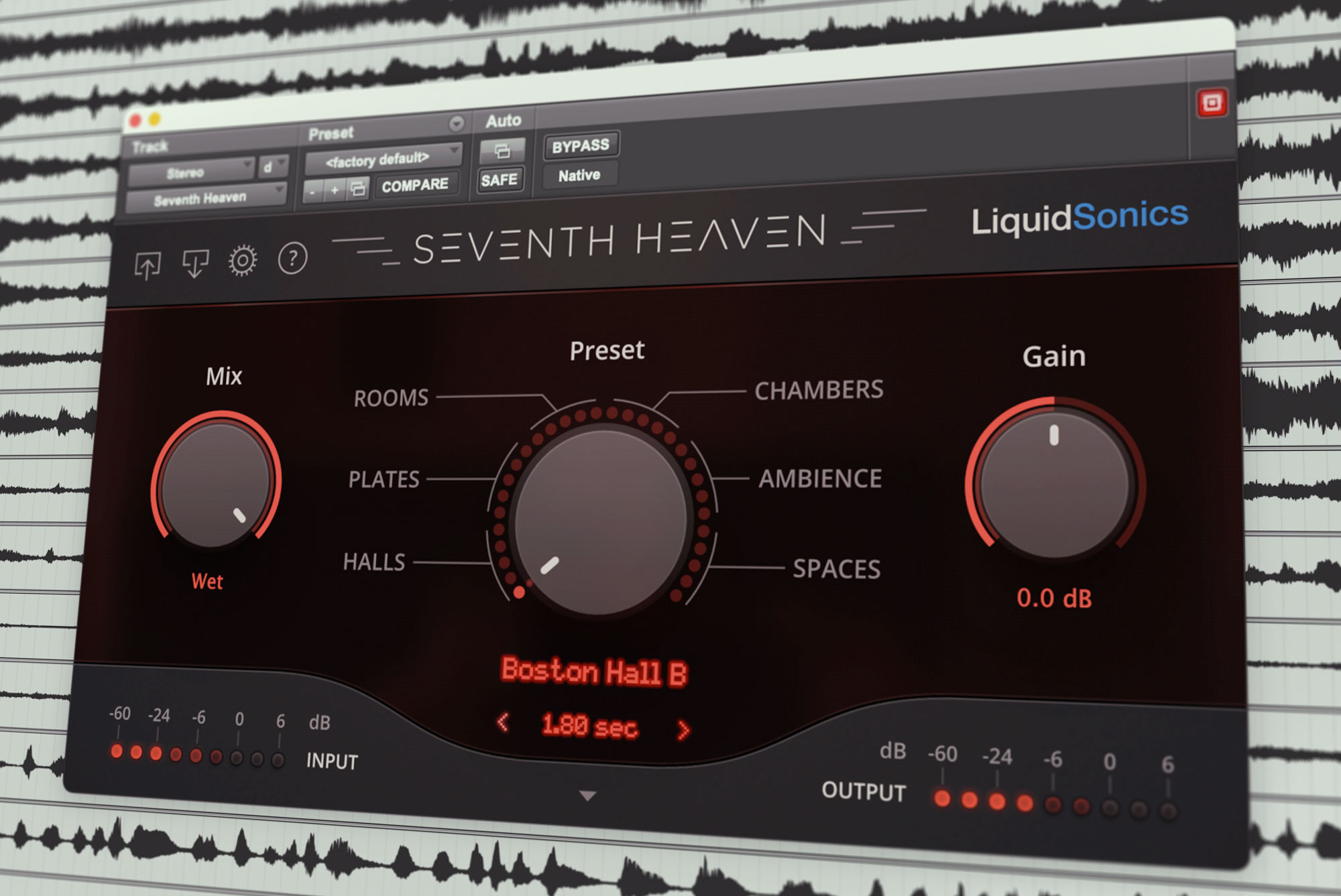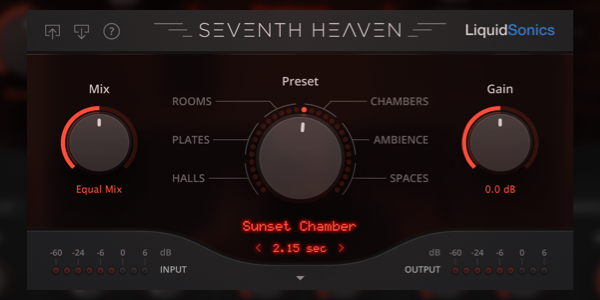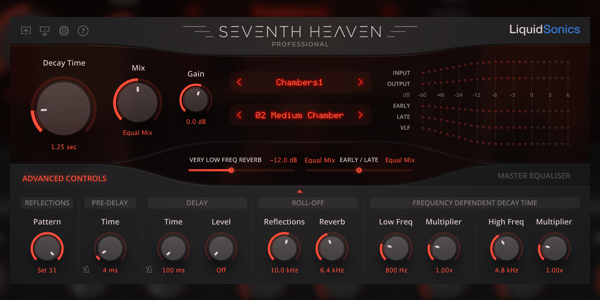
The standard edition of Seventh Heaven offers some fantastic presets such as Sunset Chamber, London Plate, and Scoring Stage. However, the presence of one preset often raises a question.
Many producers love Boston Hall B but wonder about the difference between it and Boston Hall A in Seventh Heaven Professional – the answer is that the B variant is a model when the space is full of people ready for a performance, and the A variant is when the room is empty.
By examining the differences in the preset we have a wonderful opportunity to consider some simple reverb techniques and basic acoustics that you can use to improve the emotional impact of a mix by considering the tone of the room.
Offering a fresh perspective on designing presets that will resonate with engineers, this article is perfect if you are looking to deepen your understanding of reverb and enhance a simulated room’s authenticity – it might just change the way you think about the spaces your music inhabits forever!
Rooms Full Of Bodies
Maybe you’re the fashionably late type. If you’re not, you’ll know only too well that any concert hall, stadium or club sounds completely different if you’re the first through the door compared to the moments just before a gig starts. Not only because of the room being flooded with chatter and footsteps, but because the acoustics of a room change enormously as it fills with people.
Over half of our body is made up of water, so a packed venue is absolutely full of a material that affects sound propagation enormously. Live music is about more than just the performance as the social experience plays a big role. A part of any social experience comes from what our surroundings sound like. We just don’t hang around in empty spaces all that often and rarely listen to live music in large rooms by ourselves, so empty rooms don’t quite sound right on an emotional level. It just doesn’t connect with our lived experiences.
If you’re not really the live music type you’ll probably know that when you move house it doesn’t feel quite like your home until the sofas, bookcases and other furnishings arrive because the space sounds so empty. We erode that feeling of emptiness as we introduce extra masses and irregular surfaces to a space because the room’s reflections scatter and diffuse more, and top end rolls-off more quickly as sound gets absorbed by the heavy or dense materials. Then we begin to associate this kind of a sound with the emotional connections in a home.
This is something to be aware of especially with sampled convolution reverb, as for practical reasons they are typically sampled without many people in the space.
How Reverb Sets The Tone
One of the biggest challenges in reverb preset design therefore is to take into account whether we are trying to design a preset that sounds sparse yet intimate or densely epic. A solo performer playing to a small crowd in a club or larger venue has a totally different feel to some kind of a grand occasion like a classical performance in a concert hall that is full of performers, or a rock gig in a packed-out stadium. In the former case we experience more exposed specular reflections and less damping than if we are trying to simulate a heavily diffused and damped room full of people.
Most producers have an instinctive feel for this when auditioning presets, but it can help to think about what is triggering that response. It might guide you to a better result if you think about what is supposed to be going on in the space socially if you like a preset but want to tweak it a little because the emotion doesn’t quite feel right. What kind of environment would the listener of that type of music feel familiar in?
To use an extreme example, would you head straight to a tiled room reverb for rock kit or vocal line when that kind of music that begs to be experienced in an arena full of moshing rockers? Stadia don’t sizzle – so probably not. Although it might have a suitably long reverb time it would probably not have much of a grand and epic feel to it. Some obvious problems are that the space is not diffuse enough (i.e the reflections are too specular / clattery) and that it needs far more damping as sound loses top end quite quickly in a large space full of bodies. Then again, a concrete garage might be a suitable venue, which again has another kind of character.
A Practical Example – Boston Hall A vs Boston Hall B
That brings us back to the original point – why does the standard edition of Seventh Heaven include Boston Hall B, rather than Boston Hall A?
Well it’s a fantastic space in either dress, but the big difference is that the B variant was designed to reproduce the acoustics of the revered symphony hall in Massachusetts when it is hosting a capacity crowd. The A variant is when it is empty. So while the acoustics of the venue are wonderful either way, it is perhaps a more musically useful preset when bustling with bodies. The master stroke of this preset is that the team at Bricasti didn’t just make a great room based on what it sounds like every day at 9am, they took the time to consider how the room sound during a performance too!
During an interview in Amazona, Bricasti’s Brian Zolner explained the method and approach they used when designing some of the presets and the Boston Hall pair specifically in this excerpt (translated from the original German web source using Google Translate):
“We created many presets based on various recordings of real environments. We also placed microphones in rooms and recorded the reverb and then recreated it with the M7 parameters. Since we did this during development, we think the M7 does a very good job of emulating real rooms. Our beta device was used with great success for recordings made at the Boston Concert Hall. It’s important to keep in mind that our ‘Boston Hall A’ preset is not actually the hall, but an approximated version through our preset when it is empty. ‘Boston Hall B’ is a preset that we modelled after the full hall. And when using this preset, the M7 can shine with a very natural reverb that is just as great as the real Boston Hall sounds.”
Let’s dive a little deeper and consider the main elements that affect the tone (frequency spectra) of the room itself by comparing elements of the two presets.
- Reflections roll-off:
- Boston Hall A: 15.6 kHz
- Boston Hall B: 10.4 kHz
- Discussion: The overall brightness of the reflections is reduced by the additional high frequency attenuation of people within the room
- Late roll-off:
- Boston Hall A: 6 kHz
- Boston Hall B: 4.8 kHz
- Discussion: Both are fairly dark given the volume of the space, but as above the roll-off of high frequencies will be a little more rapid
- VLF (very low frequency reverb):
- Boston Hall A: -2 dB
- Boston Hall B: -9 dB
- Discussion: The empty room sounds a little more boomy in the very low register as there are fewer sources of low frequency attenuation on the floor to disperse or absorb low resonance build-up
- Reverb time:
- Boston Hall A: 2.1 seconds
- Boston Hall B: 1.8 seconds
- Discussion: A small reduction in reverb time is natural given the a higher amount of total energy absorption by the additional masses in the space
- Frequency-dependent reverb time multipliers:
- Boston Hall A: 30% cut (0.7x) at 3.6 kHz (high reverb time reduction); 5% boost (1.05x) at 280 Hz (low reverb time extension)
- Boston Hall B: 30% cut (0.7x) at 2.8 kHz (high reverb time reduction); 5% boost (1.05x) at 720 Hz (low reverb time extension)
- Discussion: High frequency damping is approximately equal in timings, but we observe a more rapid drop-off in frequencies due to greater absorption so the cut point is lower (it would also be acceptable to adjust the percentage in some cases, it differs on a case-by-case basis)
These are all parameters you can adjust in Seventh Heaven Professional so if you would like to learn more about reverb preset design you will have the appropriate tools at hand to dive deeper into this fascinating subject.
The Room The Mix Lives In
Whatever preset you choose, in whatever reverb you have, it’s often worth thinking about how you can influence the emotional impression that a room simulation can imprint on a mix.
We can do that by not only considering a room’s structure, but also what’s inside it. Should the room be full or empty, and what is the audience’s experience in that moment going to be like – is it intimate or epic? So whether it’s a quick tweak of the reflections, or taking a little more time with your reverb time multipliers and filter cut-off points, you have the power to make that connection through your mix.
Try Seventh Heaven For Yourself
Powered by Fusion-IR, Seventh Heaven is the closest native reverb available to the wonderful Bricasti M7 hardware. Both editions come with more control over the reverb early/late mix, unique low frequency processes, pre-delay and decay time than any other sampled M7 reverb. The professional edition allows you further control over reflection sets, delay level, and independent early/late filtering with a level of fidelity only surpassed by the hardware itself.
All LiquidSonics reverbs are available to try for free for 14 days, just head to our demos page to drop a code into your license manager and pick up the installers from the downloads page to check them out for yourself.


